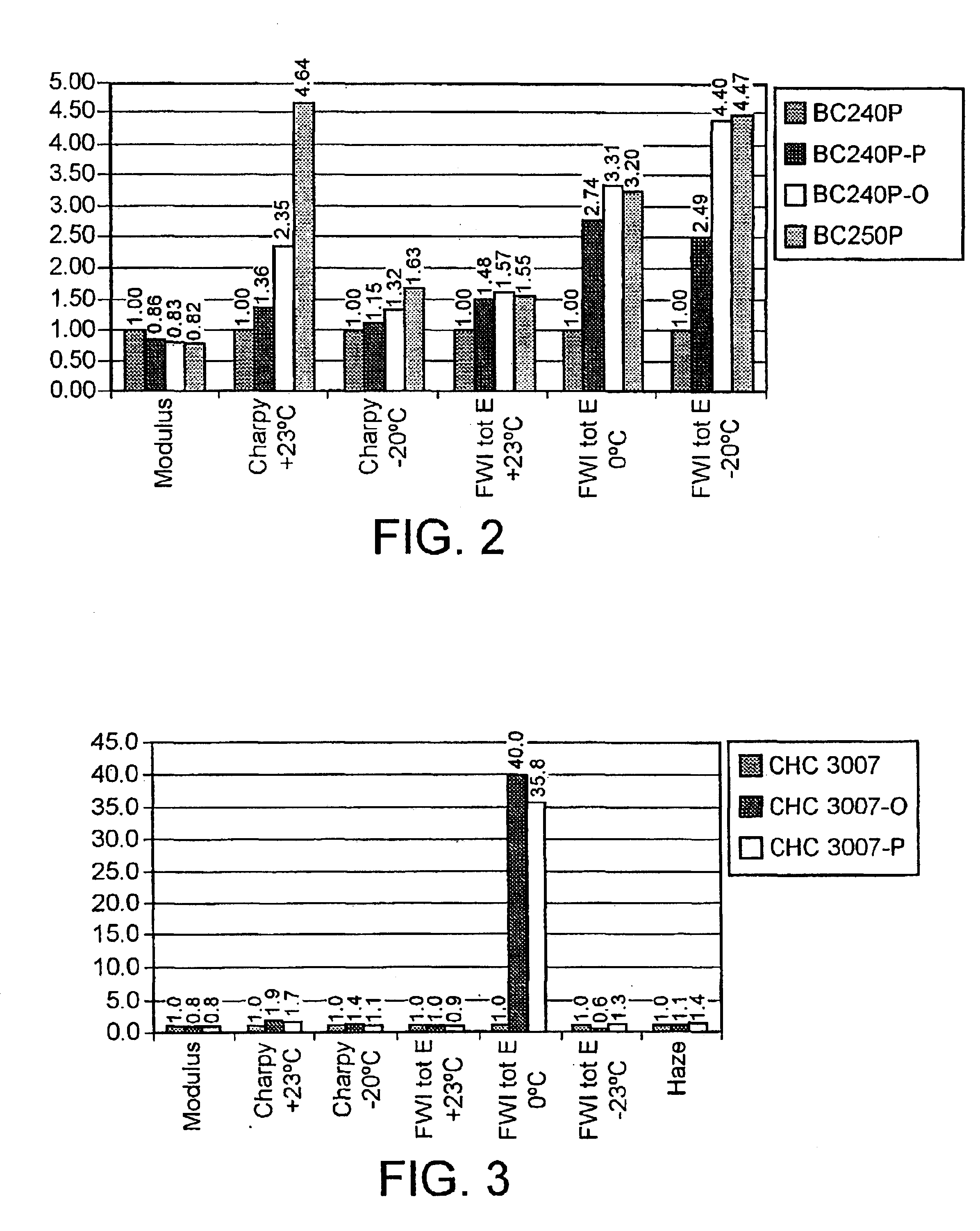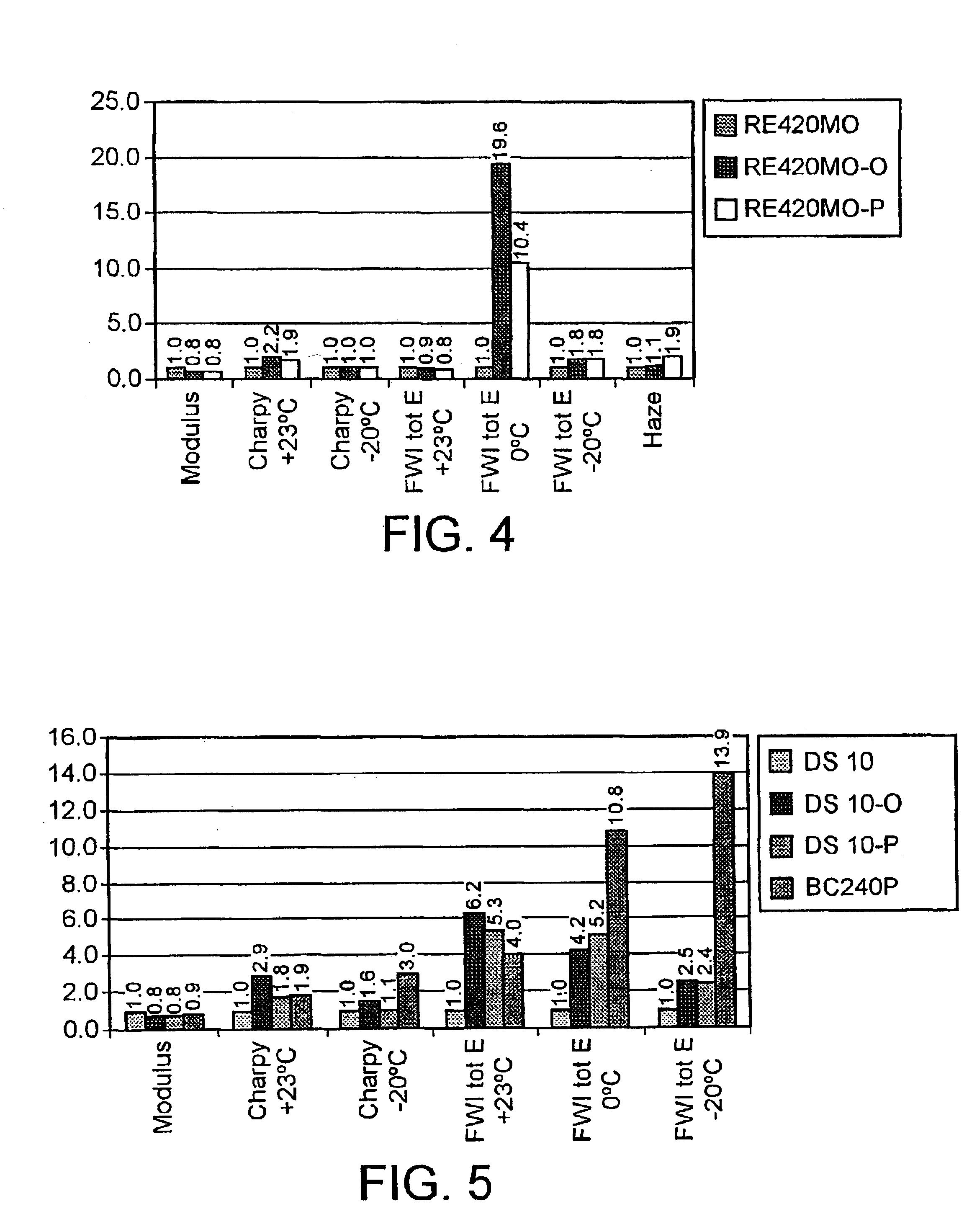Process for producing propylene based polymer compositions
a technology of propylene and polymer composition, applied in the field of propylene based polymer composition, can solve the problems of limiting the use of such materials in cases, poor impact resistance of certain polypropylene polymers, and heterophasic polypropylene copolymers being susceptible to stress whitening
- Summary
- Abstract
- Description
- Claims
- Application Information
AI Technical Summary
Benefits of technology
Problems solved by technology
Method used
Image
Examples
example 2
Compounding Process
Polypropylene random copolymers produced using Ziegler-Natta catalysts are co-extruded with single site polyethylene copolymers produced using octene and butene. Extrusion may be effected using a conventional twin-screw extruder (e.g. available from Werner & Pfleider (W & P), Germany operated at a temperature of from 200 to 300.degree. C., a screw speed of about 400 rpm, and at a specific energy input in the range of from 100 to 300 kWh per 1000 kg polymer.
example 3
Preparation of a C3 Plastomer
A total of 950 g C3 plastomer (Samples 1-10) was produced using a Gas Phase reactor (bench scale). Each polymerization reaction was effected using the catalyst bis-indenyl-zirconium-di-chloride (supported on silica) with MAO as a co-catalyst under the following reaction conditions:
In each case, 0.2% anti-oxidant (Irganox 1010 from Ciba) was added to the final polymer powder. The anti-oxidant was added as a solution in methanol and the solvent was subsequently evaporated at ambient temperature.
The properties of Samples 1-10 are shown in Table I below:
Samples 1-10 were subsequently compounded in a 16 mm Prism extruder (available from PRISM, Staffordshire, UK). MFR.sub.21 of the final product at 230.degree. C. was 1.0 g / 10 min.
example 4
Preparation of Polymer Blends With C3 and C8 Plastomers
Various polymer materials were obtained as set out in Table II below. Polymer blends were prepared by compounding the basic polypropylene material with the plastomer using a 16 mm Prism extruder.
Specimens were analysed to determine the following properties:
Falling Weight Impact (FWI) determined according to DIN53443
Optical Properties (Haze) measured for 2 mm injection moulded plates according to ASTM D1003
Tensile Modulus determined according to ISO 572-2
Charpy notched impact determined according to ISO 179 / 1 eA
Mechanical properties of the polymer blends relative to that of the basic polypropylene material are shown in attached FIGS. 2 to 5.
FIG. 2 shows that by adding 15 wt. % C8 plastomer, FWI@ -20.degree. C. can be increased to a level of 4.5 times that of the basic polypropylene material (BC240P). This is roughly equivalent to that of the reference material BC250P (available from Borealis A / S, Denmark). By adding 15 wt. % C3 p...
PUM
| Property | Measurement | Unit |
|---|---|---|
| Melt Flow Rate | aaaaa | aaaaa |
| Melt Flow Rate | aaaaa | aaaaa |
| Melt Flow Rate | aaaaa | aaaaa |
Abstract
Description
Claims
Application Information
 Login to View More
Login to View More - R&D
- Intellectual Property
- Life Sciences
- Materials
- Tech Scout
- Unparalleled Data Quality
- Higher Quality Content
- 60% Fewer Hallucinations
Browse by: Latest US Patents, China's latest patents, Technical Efficacy Thesaurus, Application Domain, Technology Topic, Popular Technical Reports.
© 2025 PatSnap. All rights reserved.Legal|Privacy policy|Modern Slavery Act Transparency Statement|Sitemap|About US| Contact US: help@patsnap.com



